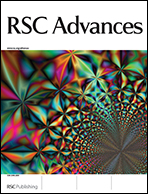Flower-like ZnO grown on urchin-like CuO microspheres for catalytic synthesis of dimethyldichlorosilane†
Abstract
We report the rational growth of flower-like ZnO on urchin-like CuO (f-ZnO@u-CuO) microspheres via a facile solvothermal method using copper nitrate and zinc nitrate as precursors in the presence of sodium nitrate and ethanol. A formation mechanism was proposed based on the observation of a series of reaction intermediates. The samples were characterized by X-ray diffraction, transmission electron microscopy, scanning electron microscopy with energy-dispersive X-ray spectroscopy, X-ray photoelectron spectroscopy, inductively coupled plasma optical emission spectrometer, and temperature-programmed reduction. It was found that the morphology of the samples was highly dependent on the synthesis conditions, particularly the reaction time and the ammonia amount added. As a copper-based catalyst for dimethyldichlorosilane synthesis via the Rochow reaction, f-ZnO@u-CuO microspheres show better catalytic performance than the Cu-based catalysts physically mixed with ZnO promoter, probably because of the well-developed p-n heterojunction structures at the CuO and ZnO interfaces that generate a much strong synergistic effect. The work provides a simple method to synthesize hierarchical CuO/ZnO composites and would be helpful for understanding the catalytic mechanism of the Rochow reaction.


 Please wait while we load your content...
Please wait while we load your content...